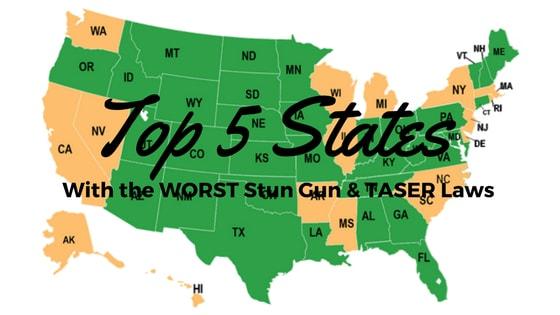Table of Contents
- California Implements Strict Stun Gun Prohibition in Educational and Public Facilities
- Legal and Safety Implications of the New Stun Gun Ban in Airports and Government Buildings
- Impact on Security Protocols and Law Enforcement Practices Across the State
- Guidelines for Compliance and Recommendations for Public Awareness Campaigns
- Insights and Conclusions
California Implements Strict Stun Gun Prohibition in Educational and Public Facilities
In a decisive move to bolster public safety, California has enacted comprehensive regulations that strictly prohibit the possession and use of stun guns within schools, airports, and government buildings. This legislative action aims to mitigate potential threats by eliminating the presence of electric weapons in high-traffic and sensitive areas. Officials emphasize that the ban targets not only students and staff but also visitors, ensuring a uniformly secure environment. The law incorporates rigorous enforcement measures, including enhanced security screenings and penalties for violations, reflecting the state’s commitment to maintaining order and protecting citizens from emerging risks associated with non-lethal weapons.
Key highlights of the new policy include:
- Zero tolerance for stun guns during campus hours or public access periods.
- Mandatory signage at all entry points informing individuals of the prohibition.
- Increased authorization for law enforcement to confiscate devices found on premises.
- Outreach programs to educate communities on the dangers and legal implications related to stun gun possession in these venues.
Legal and Safety Implications of the New Stun Gun Ban in Airports and Government Buildings
California’s decision to enforce a ban on stun guns in sensitive locations such as airports, schools, and government buildings introduces significant legal ramifications for both residents and visitors. Individuals found in possession of these devices within restricted zones are subject to fines, confiscation, and possible criminal charges, aligning with the state’s commitment to enhancing public safety. Law enforcement agencies are now tasked with implementing stricter screening protocols and updating training to appropriately address and manage instances involving stun guns, ensuring adherence to the new regulatory framework.
From a safety standpoint, the ban aims to mitigate risks associated with the misuse of stun guns in high-security environments. Key considerations include:
- Prevention of unauthorized force: Reducing access to potentially harmful devices helps prevent accidents and intentional misuse within crowded public spaces.
- Enhanced emergency response: Limiting stun gun possession facilitates smoother emergency interventions by security personnel.
- Public reassurance: The ban supports a broader strategy to cultivate safer environments where citizens feel secure against threats involving electrical weapons.
Impact on Security Protocols and Law Enforcement Practices Across the State
Law enforcement agencies and security personnel across California must now recalibrate their operational frameworks to comply with the new regulatory landscape. The prohibition on stun guns within sensitive locations necessitates enhanced screening processes and the adoption of alternative non-lethal tools. Agencies are prioritizing training programs to ensure officers are well-versed in de-escalation techniques and equipped with compliant defensive technologies, aligning public safety measures with the legal mandates. This shift underscores a broader commitment to balance effective enforcement with safeguarding communal security standards.
Key adjustments in law enforcement and security protocols include:
- Implementation of stricter access controls and frisking procedures at government buildings, airports, and educational institutions.
- Introduction of advanced detection systems to identify prohibited devices before entry.
- Mandatory refresher courses focusing on alternative compliance tools and crisis management.
- Partnerships with community organizations to foster awareness and cooperation regarding the new regulations.
Consequently, law enforcement’s operational cadence is evolving, with a heightened emphasis on preventive measures and community-sensitive practices. The move aims not only to fortify physical security but also to promote a culture of trust and transparency between the public and governing bodies.
Guidelines for Compliance and Recommendations for Public Awareness Campaigns
To ensure effective adherence to the new restrictions, authorities must implement a robust framework that includes clear protocols for security personnel and regular training updates. Institutions affected by the ban should establish comprehensive screening procedures at entry points, backed by frequent compliance audits to identify potential oversights. Leveraging technology, such as advanced scanning devices, will further enhance the detection of prohibited stun guns while minimizing disruptions. Additionally, collaboration between state agencies and local law enforcement is vital for consistent enforcement and swift response to violations.
Public education campaigns play a critical role in raising awareness about the ban and its rationale. Strategic outreach efforts should utilize multiple platforms-including social media, community workshops, and informational signage-to communicate the new safety standards to diverse audiences effectively. Key messages must emphasize the risks associated with stun guns in sensitive environments and the benefits of maintaining secure public spaces. Engaging local leaders and organizations can amplify these campaigns, fostering a culture of shared responsibility and vigilance among residents and visitors alike.
Insights and Conclusions
In response to increasing concerns over public safety, California’s decision to ban stun guns in schools, airports, and government buildings marks a significant step toward tightening security measures in sensitive locations. As the state enforces these new restrictions, officials emphasize the importance of balancing individual rights with the need to protect communities from potential threats. The implementation of this ban will likely prompt ongoing discussions about effective ways to ensure safety while respecting lawful possession of personal defense tools in other contexts. Stakeholders and residents alike will be watching closely to assess the impact of these changes in the months ahead.Check Our Other Blogs
- StunGun – Your Trusted Source for Stun Guns, Laws, and Self-Defense Tips
- PepperSprayLaws – Your Trusted Resource for Pepper Spray Information
- StunGunLaws – Your Trusted Guide to Stun Gun Legality and Safety





